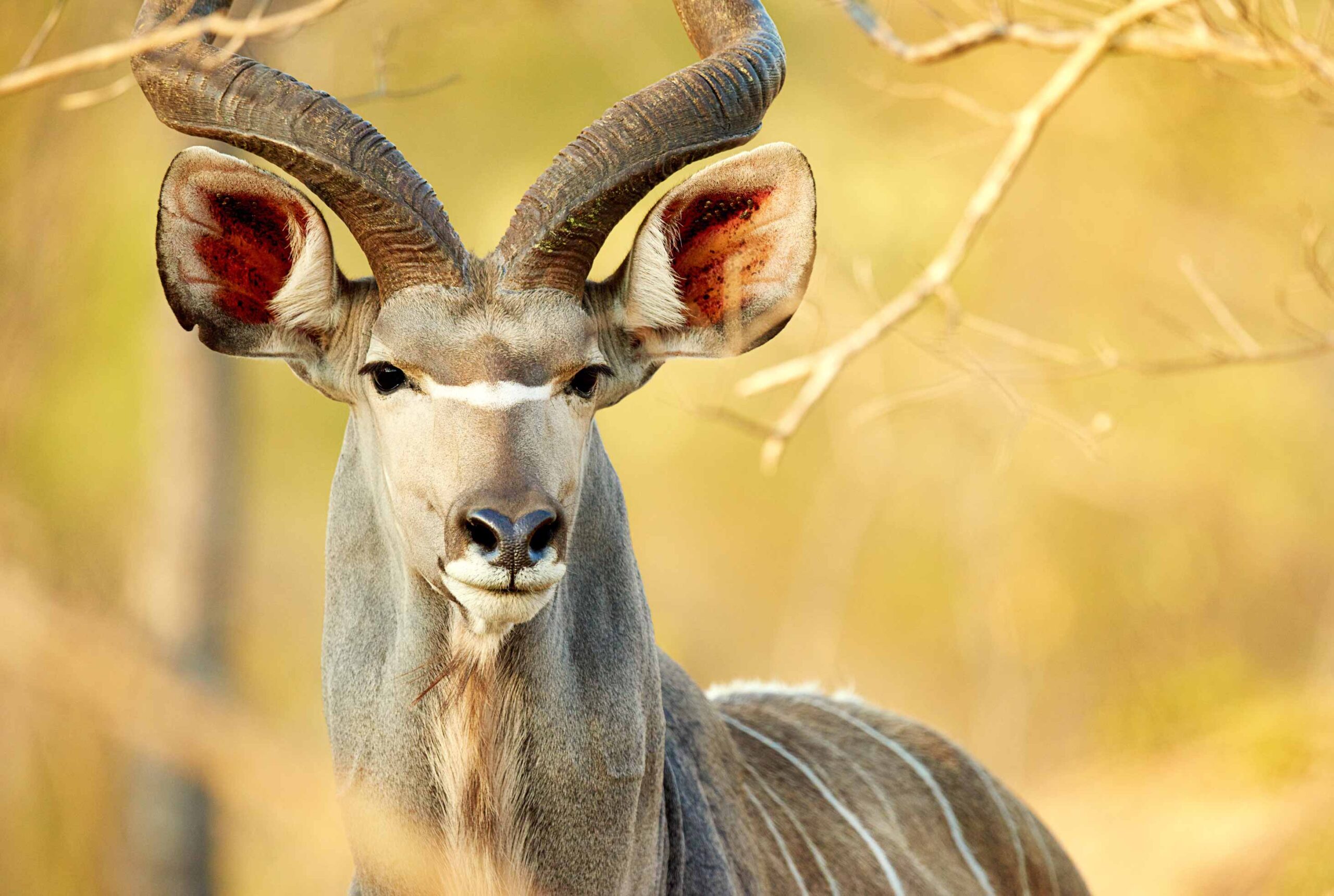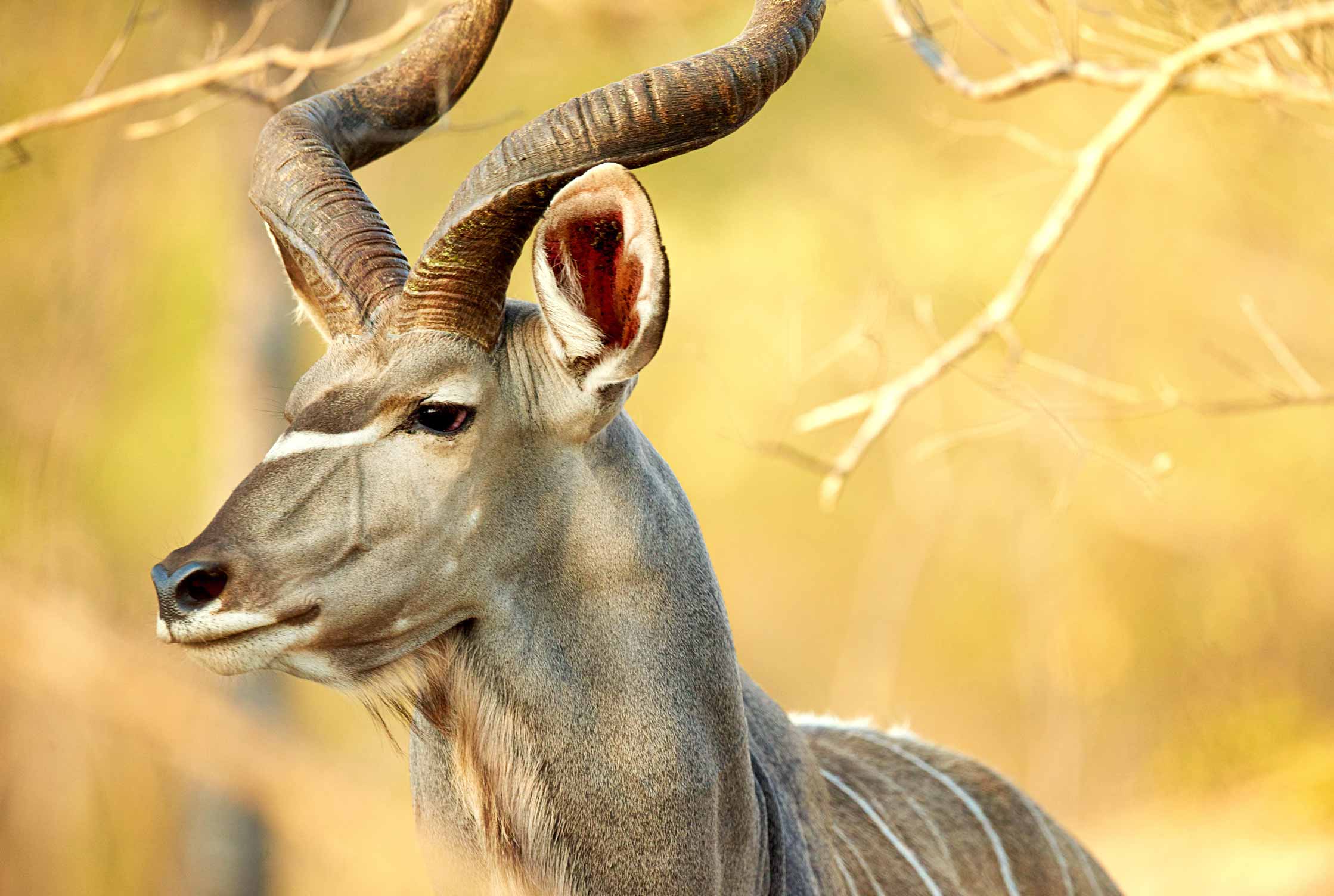Kudu

Overview
The kudu belongs to the Bovidae family, which includes other large antelopes, cattle, goats, and sheep. Scientifically known as Tragelaphus strepsiceros for the greater kudu and Tragelaphus imberbis for the lesser kudu, this species is widely recognized for its striking physical appearance, characterized by long, spiral horns and a coat adorned with white stripes.
Scientific Classification
- Kingdom: Animalia
- Phylum: Chordata
- Class: Mammalia
- Order: Artiodactyla
- Family: Bovidae
- Subfamily: Bovinae
- Genus: Tragelaphus
- Species: Tragelaphus strepsiceros (Greater Kudu)
- Species: Tragelaphus imberbis (Lesser Kudu)
Description
Physical Characteristics
The kudu is one of the most visually striking antelopes in Africa, easily recognizable by its large, spiraled horns and sleek, striped coat. The greater kudu, Tragelaphus strepsiceros, can stand up to 1.5 meters (5 feet) at the shoulder and weigh between 190 and 270 kilograms (420 to 600 pounds). Males are notably larger than females and are the only ones to possess the iconic spiral horns, which can grow up to 1.8 meters (6 feet) in length, making them one of the longest horns among all antelope species. These horns spiral in two and a half turns and are not just for show; they are used in sparring matches between males during the mating season.
The kudu’s coat is a muted brown or bluish-gray, adorned with 6 to 10 vertical white stripes running along its sides. This coloration, combined with its stripes, provides excellent camouflage in the dappled light of its natural woodland and savanna habitats. The face of the greater kudu is marked by a white chevron between the eyes, enhancing its distinguished appearance.
In contrast, the lesser kudu, Tragelaphus imberbis, is smaller, with males standing about 1 meter (3.3 feet) at the shoulder and weighing up to 115 kilograms (250 pounds). The lesser kudu also features a similar coat pattern, though it is more reddish-brown, and the white stripes are more pronounced. The horns of the lesser kudu, though still spiraled, are shorter and more tightly coiled than those of the greater kudu, usually completing two full twists.
Unique Traits
Apart from their horns and coat patterns, kudus are also known for their large, sensitive ears, which are adapted for detecting predators in their environment. These ears are constantly alert, rotating independently to capture the slightest sounds, which aids in their survival in the wild.
Kudus are also incredibly agile and can leap over obstacles as high as 2.5 meters (8 feet) when evading predators. This agility, combined with their ability to blend into their surroundings, makes them difficult targets for natural predators such as lions, leopards, and wild dogs.

Behaviour
Kudus are generally shy and elusive animals, preferring to stay within the cover of dense bushland and thickets. They are most active during the early morning and late afternoon, avoiding the heat of the midday sun. Despite their large size, kudus are remarkably quiet and can move through thick vegetation almost silently.
Social Structure
Kudus are primarily social animals, with females and their young forming small groups known as herds. These herds typically consist of 6 to 10 individuals, although larger aggregations may form during the dry season when water and food sources are scarce. Adult males, on the other hand, are usually solitary or form small bachelor groups. They join female herds only during the mating season, known as the rut, which occurs during the rainy season.
Diet
As herbivores, kudus have a diet that primarily consists of leaves, shoots, grass, and fruits. They are browsers, meaning they prefer to feed on foliage from trees and shrubs rather than grazing on grass. This browsing diet allows them to obtain moisture from the leaves they consume, reducing their dependence on water sources. However, kudus will drink regularly when water is available and are known to travel long distances to find water during droughts.
Reproduction and Lifespan
The breeding season for kudus varies depending on their geographical location but generally coincides with the rainy season when food is plentiful. During this time, males become more aggressive and engage in elaborate displays of dominance, including locking horns with rivals in intense, yet usually non-lethal, battles.
Courtship and Mating
Once a male has established dominance, he will court a receptive female through a series of behaviors, including following her closely, grooming, and making soft vocalizations. After a gestation period of about 8 months, the female gives birth to a single calf, which she hides in dense vegetation for the first few weeks of its life to protect it from predators.
Lifespan
In the wild, kudus have an average lifespan of about 7 to 8 years, although some individuals may live longer, especially in protected areas where they are less exposed to predators and human threats. In captivity, kudus can live up to 15 years, thanks to the absence of predators and a consistent food supply.
Habitat
Kudus are widely distributed across Eastern and Southern Africa, inhabiting a range of environments from dry savannas and open woodlands to hilly regions and mountainous forests. The greater kudu is more widespread, found in countries such as South Africa, Namibia, Botswana, Zimbabwe, Kenya, Tanzania, and Mozambique. It thrives in areas where it can find ample cover from predators, typically in woodland and bushland regions with access to water.
The lesser kudu has a more restricted range, primarily found in the arid and semi-arid regions of Eastern Africa, including Ethiopia, Somalia, Kenya, and Tanzania. It favors areas of thick, dry bushland and is less dependent on water sources than its larger cousin, making it well-adapted to the drier climates of its habitat.
Both species have adapted to survive in environments where they are vulnerable to predation, relying on their cryptic coloration, alertness, and agility to evade danger. However, habitat loss due to human encroachment and agriculture poses a significant threat to their survival.
Conservation
Several conservation programs are in place to protect kudu populations. These initiatives focus on habitat preservation, anti-poaching efforts, and community-based conservation projects that involve local populations in wildlife protection. National parks and wildlife reserves across Africa, such as Kruger National Park in South Africa, Serengeti National Park in Tanzania, and Etosha National Park in Namibia, provide crucial sanctuaries where kudus can thrive away from human pressures.
Additionally, organizations like the African Wildlife Foundation and World Wildlife Fund are working to promote sustainable land use practices that balance the needs of wildlife with those of local communities. These efforts are essential for ensuring the long-term survival of the kudu and other African wildlife species.
Facts
Interesting facts about The Kudu.
Kudu horns are long and spiraled, primarily serving as a tool for males during combat over mating rights. The horns also play a role in species identification and sexual selection.
No, only male kudus possess horns. Females do not have horns, which is common among many antelope species where only males engage in direct combat for mating opportunities.
Kudus use their excellent camouflage, keen hearing, and agility to evade predators. They can also leap high obstacles and move silently through dense vegetation.
Kudus are browsers, primarily feeding on leaves, shoots, grass, and fruits. Their diet allows them to derive moisture from their food, reducing their dependence on water sources.
Kudus can be seen in several national parks and reserves across Eastern and Southern Africa, including Kruger National Park in South Africa and Serengeti National Park in Tanzania.
Kudus are not currently endangered but face threats from habitat loss, poaching, and competition with livestock, which could lead to population declines if not properly managed.
Kudus play a crucial role in their ecosystem as browsers, helping to control the growth of vegetation. They are also an important prey species for large predators like lions and leopards.
Kudus can run at speeds of up to 70 kilometers per hour (43 miles per hour) when evading predators, but they rely more on their ability to leap and maneuver through dense cover.
Kudus communicate using a variety of vocalizations, including grunts, snorts, and barks. These sounds are often used to alert others of potential danger.
In the wild, kudus typically live for 7 to 8 years, though they can live longer in protected areas. In captivity, they may live up to 15 years.
Other Animals
Explore fauna in Africa.








